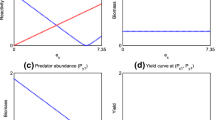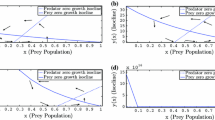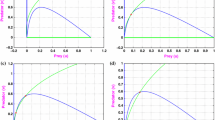Abstract
Most research articles on the exploited predator–prey dynamics study the asymptotic profile of steady states, bistability, limit cycles and bifurcations. In these cases, the disturbances (harvesting) can lead to transient amplification before decaying asymptotically. Therefore, a deep understanding of transient dynamics near steady state is crucial to guessing the dynamics of interacting species for disturbances on short time scales. Here, we study this transient indicator to a generalist predator–prey system with Holling type III functional response. The disturbances are produced by different harvesting strategies, including prey harvesting, predator harvesting, and simultaneous harvesting of both species. In the case of the existence of unique interior equilibrium, the stable steady state becomes reactive. The results become complicated when the system becomes bistable in nature. Between two stable coexistence states, one becomes reactive, and another remains non-reactive. But it is observed that disturbance made by harvesting in our system affects the transient behavior of the system making it more stable in nature in every case compared to the unharvested system. We also observe that the MSY policy is suitable for prey and simultaneous harvesting of both species in comparison with predator harvesting.


















Similar content being viewed by others
Data Availability Statement
No data are associated with the manuscript.
References
L.N. Guin, G. Mandal, M. Mondal, S. Chakravarty, A chaotic tri- trophic food chain model supplemented by Allee effect. Int. J. Dyn. Control, 1–27 (2022)
S. Mondal, G.P. Samanta, J.J. Nieto, Dynamics of a predator-prey population in the presence of resource subsidy under the influence of nonlinear prey refuge and fear effect. Complexity. (2021)
D. Das, D. Pal, T.K. Kar, K.S. Chaudhuri, Balanced harvesting in two predators one prey system. J. Appl. Math. Comput. 68(2), 839–861 (2022)
M.G. Neubert, H. Caswell, Alternatives to resilience for measuring the responses of ecological systems to perturbations. Ecology 78(3), 653–665 (1997)
X. Chen, J.E. Cohen, Global stability, local stability and permanence in model food webs. J. Theor. Biol. 212(2), 223–235 (2001)
H. Caswell, M.G. Neubert, Reactivity and transient dynamics of discrete-time ecological systems. J. Differ. Equations Appl. 11(4–5), 295–310 (2005)
G.R. Hosack, P.A. Rossignol, P. Van Den Driessche, The control of vector-borne disease epidemics. J. Theor. Biol. 255(1), 16–25 (2008)
A. Hastings, K. C. Abbott, K. Cuddington, T. Francis, G. Gellner, Y.-C. Lai, A. Morozov, S. Petrovskii, K. Scranton, M. L. Zeeman, Transient phenomena in ecology. Science, 361(6406) (2018)
R.E. Snyder, What makes ecological systems reactive? Theor. Popul. Biol. 77(4), 243–249 (2010)
R. Vesipa, L. Ridolfi, Impact of seasonal forcing on reactive ecological systems. J. Theor. Biol. 419, 23–35 (2017)
J. Dixon, A. Lindemann, J.H. McCoy, Transient amplification limits noise suppression in biochemical networks. Phys. Rev. E 93(1), 012415 (2016)
B.F. Farrell, P.J. Ioannou, Generalized stability theory. Part I: Autonomous operators. J. Atmosph. Sci. 53(14), 2025–2040 (1996)
J.H. McCoy, Amplification without instability: applying fluid dynamical insights in chemistry and biology. New J. Phys. 15(11), 113036 (2013)
E.M. Bennett, G.D. Peterson, L.J. Gordon, Understanding relationships among multiple ecosystem services. Ecol. Lett. 12(12), 1394–1404 (2009)
T.K. Kar, B. Ghosh, Impacts of maximum sustainable yield policy to prey–predator systems. Ecol. Model. 250, 134–142 (2013)
J.R. Beddington, R.M. May, Maximum sustainable yields in systems subject to harvesting at more than one trophic level. Math. Biosci. 51(3–4), 261–281 (1980)
E. Tromeur, D. Luc, Optimal biodiversity erosion in multispecies fisheries. Les Cahiers du GREThA-Groupe de Recherche en Économie Théorique et Appliquée(2016-20) (2016)
M.B. Schaefer, Some aspects of the dynamics of populations important to the management of the commercial marine fisheries. Int. Am. Tropical Tuna Comm. Bull. 1(2), 23–56 (1954)
C.W. Clark, Mathematical Bioeconomics: The Optimal Management of Renewable Resources, 2nd edn. (John Wiley and Sons, New York, 1990)
B. Ghosh, T.K. Kar, T. Legovic, Relationship between exploitation, oscillation, MSY and extinction. Math. Biosci. 256, 1–9 (2014)
T. Legović, Impact of demersal fishery and evidence of the Volterra principle to the extreme in the Adriatic Sea. Ecol. Model. 212(1–2), 68–73 (2008)
C.J. Walters, V. Christensen, S.J. Martell, J.F. Kitchell, Possible ecosystem impacts of applying MSY policies from single-species assessment. ICES J. Mar. Sci. 62(3), 558–568 (2005)
H. Matsuda, P.A. Abrams, Maximal yields from multispecies fisheries systems: rules for systems with multiple trophic levels. Ecol. Appl. 16(1), 225–237 (2006)
T. Legović, S. Gečcek, Impact of maximum sustainable yield on mutualistic communities. Ecol. Model. 230, 63–72 (2012)
P. Majumdar, S. Debnath, S. Sarkar, U. Ghosh, The complex dynamical behavior of a prey-predator model with holling type-iii functional response and non-linear predator harvesting. Int. J. Model. Simul. 42(2), 287–304 (2022)
A. Erbach, F. Lutscher, G. Seo, Bistability and limit cycles in generalist predator–prey dynamics. Ecol. Complex. 14, 48–55 (2013)
P. Paul, T.K. Kar, E. Das, Reactivity in prey–predator models at equilibrium under selective harvesting efforts. Eur. Phys. J. Plus 136(5), 510 (2021)
P. Paul, E. Das, T.K. Kar, Reactivity and recovery in an exploited one prey two predators system at equilibrium. Eur. Phys. J. Plus 136(11), 1148 (2021)
M.L. Rosenzweig, Paradox of enrichment: destabilization of exploitation ecosystems in ecological time. Science 171(3969), 385–387 (1971)
A. Morozov, S. Petrovskii, Excitable population dynamics, biological control failure, and spatiotemporal pattern formation in a model ecosystem. Bull. Math. Biol. 71(4), 863–887 (2009)
V.W. Rodrigues, D.C. Mistro, L.A.D. Rodrigues, Pattern formation and bistability in a generalist predator–prey model. Mathematics 8(1), 20 (2019)
B. Ghosh, T.K. Kar, Maximum sustainable yield and species extinction in a prey–predator system: some new results. J. Biol. Phys. 39(3), 453–467 (2013)
B. Ghosh, T.K. Kar, Possible ecosystem impacts of applying maximum sustainable yield policy in food chain models. J. Theor. Biol. 329, 6–14 (2013)
G.R. Huxel, K. McCann, FoodWeb stability: The influence of trophic flows across habitats. Am. Nat. 152(3), 460–469 (1998)
B. Sahoo, S. Poria, Effects of additional food in a delayed predator–prey model. Math. Biosci. 261, 62–73 (2015)
P.D.N. Srinivasu, B.S.R.V. Prasad, M. Venkatesulu, Biological control through provision of additional food to predators: A theoretical study. Theor. Population Biol. 72(1), 111–120 (2007)
B. Ghosh, D. Pal, T. Legović, T.K. Kar, Harvesting induced stability and instability in a tri-trophic food chain. Math. Biosci. 304, 89–99 (2018)
E. Tromeur, N. Loeuille, Balancing yield with resilience and conservation objectives in harvested predator–prey communities. Oikos 126(12), 1780–1789 (2017)
M.G. Neubert, T. Klanjscek, H. Caswell, Reactivity and transient dynamics of predator–prey and food web models. Ecol. Model. 179(1), 29–38 (2004)
X. Wang, M. Efendiev, F. Lutscher, How spatial heterogeneity affects transient behavior in reaction-diffusion systems for ecological interactions? Bull. Math. Biol. 81(10), 3889–3917 (2019)
W. Liu, J. Feng, Analysis of asymptotic and transient behaviors of stochastic ratio-dependent predator–prey model. Mathematics 9(21), 2776 (2021)
Acknowledgements
The work by Esita Das is financially supported by the Indian Institute of Engineering Science and Technology (IIEST), Shibpur, India (No. 1999/Exam, dated: October 01, 2021). The research of T.K. Kar is supported by the Council of Scientific and Industrial Research (CSIR) (NO.25(0300)/19/EMR-II, dated: May 16, 2019).
Author information
Authors and Affiliations
Contributions
This manuscript is prepared by Esita Das, Prosenjit Paul and T.K. Kar; Esita Das and Prosenjit Paul have taken the main role in designing the approach and performed the analysis and writing of the manuscript, with substantial input from T.K. Kar.
Corresponding author
Rights and permissions
Springer Nature or its licensor (e.g. a society or other partner) holds exclusive rights to this article under a publishing agreement with the author(s) or other rightsholder(s); author self-archiving of the accepted manuscript version of this article is solely governed by the terms of such publishing agreement and applicable law.
About this article
Cite this article
Das, E., Paul, P. & Kar, T.K. Transient indicator of exploited communities at equilibrium in generalist predator–prey models. Eur. Phys. J. Plus 137, 1221 (2022). https://doi.org/10.1140/epjp/s13360-022-03429-5
Received:
Accepted:
Published:
DOI: https://doi.org/10.1140/epjp/s13360-022-03429-5




